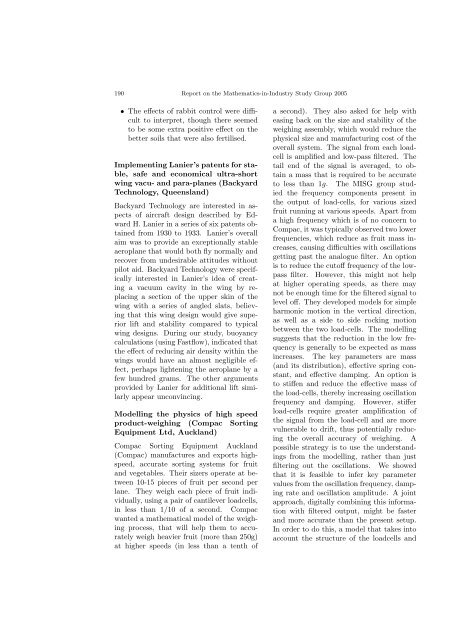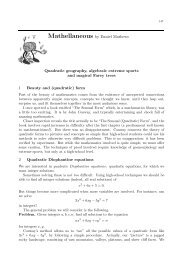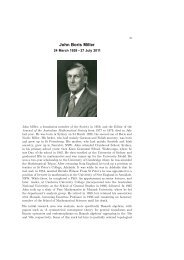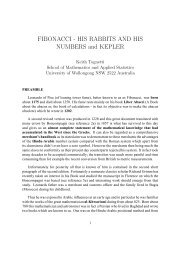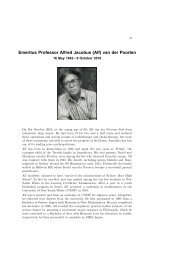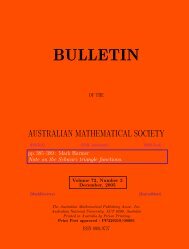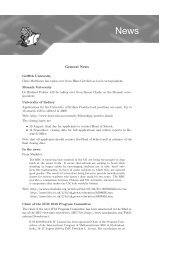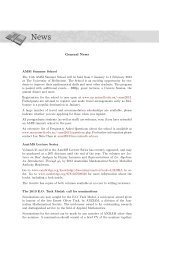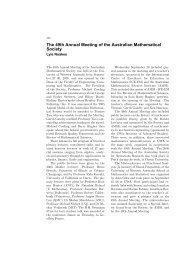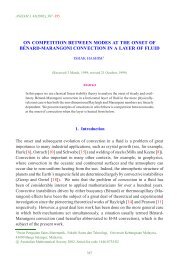Gazette 31 Vol 3 - Australian Mathematical Society
Gazette 31 Vol 3 - Australian Mathematical Society
Gazette 31 Vol 3 - Australian Mathematical Society
You also want an ePaper? Increase the reach of your titles
YUMPU automatically turns print PDFs into web optimized ePapers that Google loves.
190 Report on the Mathematics-in-Industry Study Group 2005<br />
• The effects of rabbit control were difficult<br />
to interpret, though there seemed<br />
to be some extra positive effect on the<br />
better soils that were also fertilised.<br />
Implementing Lanier’s patents for stable,<br />
safe and economical ultra-short<br />
wing vacu- and para-planes (Backyard<br />
Technology, Queensland)<br />
Backyard Technology are interested in aspects<br />
of aircraft design described by Edward<br />
H. Lanier in a series of six patents obtained<br />
from 1930 to 1933. Lanier’s overall<br />
aim was to provide an exceptionally stable<br />
aeroplane that would both fly normally and<br />
recover from undesirable attitudes without<br />
pilot aid. Backyard Technology were specifically<br />
interested in Lanier’s idea of creating<br />
a vacuum cavity in the wing by replacing<br />
a section of the upper skin of the<br />
wing with a series of angled slats, believing<br />
that this wing design would give superior<br />
lift and stability compared to typical<br />
wing designs. During our study, buoyancy<br />
calculations (using Fastflow), indicated that<br />
the effect of reducing air density within the<br />
wings would have an almost negligible effect,<br />
perhaps lightening the aeroplane by a<br />
few hundred grams. The other arguments<br />
provided by Lanier for additional lift similarly<br />
appear unconvincing.<br />
Modelling the physics of high speed<br />
product-weighing (Compac Sorting<br />
Equipment Ltd, Auckland)<br />
Compac Sorting Equipment Auckland<br />
(Compac) manufactures and exports highspeed,<br />
accurate sorting systems for fruit<br />
and vegetables. Their sizers operate at between<br />
10-15 pieces of fruit per second per<br />
lane. They weigh each piece of fruit individually,<br />
using a pair of cantilever loadcells,<br />
in less than 1/10 of a second. Compac<br />
wanted a mathematical model of the weighing<br />
process, that will help them to accurately<br />
weigh heavier fruit (more than 250g)<br />
at higher speeds (in less than a tenth of<br />
a second). They also asked for help with<br />
easing back on the size and stability of the<br />
weighing assembly, which would reduce the<br />
physical size and manufacturing cost of the<br />
overall system. The signal from each loadcell<br />
is amplified and low-pass filtered. The<br />
tail end of the signal is averaged, to obtain<br />
a mass that is required to be accurate<br />
to less than 1g. The MISG group studied<br />
the frequency components present in<br />
the output of load-cells, for various sized<br />
fruit running at various speeds. Apart from<br />
a high frequency which is of no concern to<br />
Compac, it was typically observed two lower<br />
frequencies, which reduce as fruit mass increases,<br />
causing difficulties with oscillations<br />
getting past the analogue filter. An option<br />
is to reduce the cutoff frequency of the lowpass<br />
filter. However, this might not help<br />
at higher operating speeds, as there may<br />
not be enough time for the filtered signal to<br />
level off. They developed models for simple<br />
harmonic motion in the vertical direction,<br />
as well as a side to side rocking motion<br />
between the two load-cells. The modelling<br />
suggests that the reduction in the low frequency<br />
is generally to be expected as mass<br />
increases. The key parameters are mass<br />
(and its distribution), effective spring constant,<br />
and effective damping. An option is<br />
to stiffen and reduce the effective mass of<br />
the load-cells, thereby increasing oscillation<br />
frequency and damping. However, stiffer<br />
load-cells require greater amplification of<br />
the signal from the load-cell and are more<br />
vulnerable to drift, thus potentially reducing<br />
the overall accuracy of weighing. A<br />
possible strategy is to use the understandings<br />
from the modelling, rather than just<br />
filtering out the oscillations. We showed<br />
that it is feasible to infer key parameter<br />
values from the oscillation frequency, damping<br />
rate and oscillation amplitude. A joint<br />
approach, digitally combining this information<br />
with filtered output, might be faster<br />
and more accurate than the present setup.<br />
In order to do this, a model that takes into<br />
account the structure of the loadcells and


